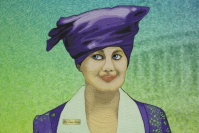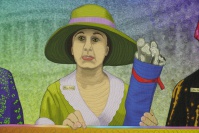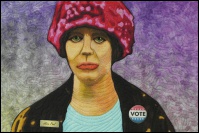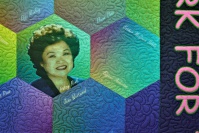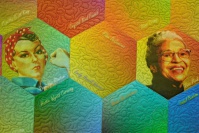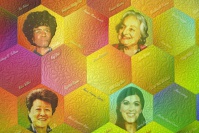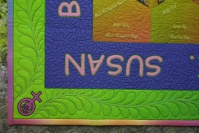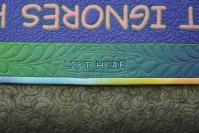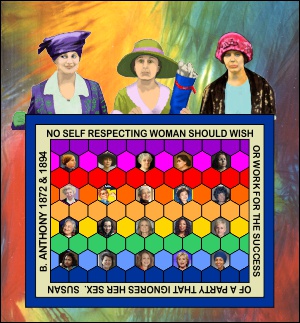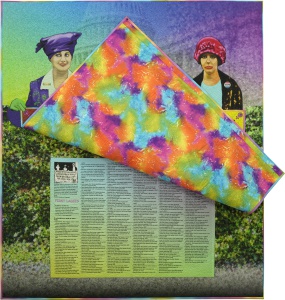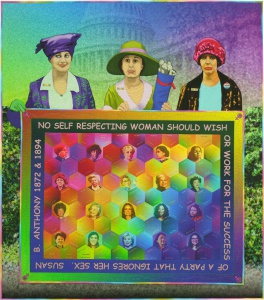 |
First Ladies
Printable version
- Copyright © 2018 Caryl Bryer Fallert-Gentry
- Size: 56" wide x 63" high
- Techniques: Digitally painted and printed, machine pieced, appliqued, and
quilted
- Fabric: 100% cotton / Batting: top quilt - 50% cotton / 50% bamboo / bottom quilt - 100% wool
- Price: $15000.00
See details & more information below
Larger image |
If
you would like to purchase or exhibit this quilt, please contact Caryl privately.
• Email • Phone: 360-385-2568 • Snail Mail: Bryerpatch Studio •10 Baycliff Place. • Port Townsend, WA 98368 |
 |
|
In September of 2017, Sandra Sider invited me to participate in a quilt exhibition called “Deeds Not Words”: The Power of Persistence, Celebrating 100 Years of Women's Suffrage, celebrating the 100th anniversary of the19th Amendment to the U.S. Constitution (August 18, 1920) granting American women the right to vote. I immediately gave an enthusiastic "yes", although I didn't have an idea of what I wanted to portray. To get ideas, I did some reading about the woman's suffrage movement online and looked at lots of images.
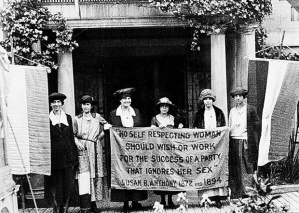 |
The one that grabbed my attention was a Library of Congress photo from June 2, 1920, in which officers of the National Woman's Party stand in front of the Washington headquarters before leaving for Chicago to take charge of the suffrage attack on the convention of the Republican Party. The banner contained a quote by Susan B. Anthony. I began making colored-pencil drawings of the women in the photo, planning to print them on fabric to be used in the quilt.
I put a copy of the photo in my computer (Corel Draw) and began playing with design possibilities. I decided to portray only the three women actually holding the banner.
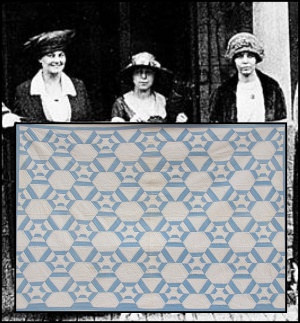 |
The photo reminded me of quilters holding up a quilt for show and tell, so I grabbed a random photo of an antique quilt and plugged it into the photo. The quilt had 60-degree triangles forming large hexagonal open spaces. It occurred to me that the open spaces could be used to depict some of the women who had moved forward the cause of women's rights, and human rights in general, in the century since the ratification of the 19th amendment. I started making a list of women I could think of who had made significant contributions, trying to find at least two from each of the intervening decades. I came up with twenty names and found pictures of each of them. As the idea progressed I abandoned the design of the antique quilt and designed a quilt center composed entirely of hexagons with the Susan B. Anthony quote in a border surrounding the center. The hexagons are similar to the traditional "Grandmother's Flower Garden" a popular pattern in the 1920's. I plugged pictures of my chosen twenty women into evenly spaced hexagons in my design and showed my design idea to my husband, Ron, who immediately said "why not Madeline Albright?". Well, because she wasn't the first woman to serve as a cabinet officer. That was Frances Perkins, back in the 1930's. There were lots of other women I would have liked to include, and I began doing more research on women who were the first of their gender or ethnicity to do things that were previously done only by men or people of other ethnicities. |
| |
|
I also wanted to include some women who, perhaps, were not the first at what they did, but made significant contributions to moving forward the cause of human rights in their generations. As my research continued, some of my original selections were replaced by others whose firsts were more significant, although I had not heard of them previously.
Eventually I compiled a list of 162 names of women who accomplished important firsts in our country in the last 100 years. (Click here for the full list.) I decided to include all of these names in the blank hexagons knowing that many of the names
would be unfamiliar to viewers. I thought about putting a key on the back of the quilt but knew it might be hard to read once the quilting stitches were added and no one at an exhibition would ever see it. At that point I got the idea of making the hexagonal quilt as a separate element, a quilt within the quilt, that could be lifted, with the list of names and accomplishments underneath. I even included a "lift here" sign at the bottom.
By this time, (Summer of 2018) I had purchased a new "Surface Design Studio" computer that allows me to draw and paint right on the computer screen. I experimented with some of the faces in the old photos and was soon having a very good time playing with all of the brushes, pencils, and unlimited colors available in Corel Photo Paint. I decided to use only the three women actually holding the banner and started my digital paintings with them. Eventually I also made digital paintings of all twenty of the women in the hexagons. For several years I had been meaning to try having some custom fabric printed by Spoonflower but it had not yet reached the top of my to-do list. At this point, the design for First Ladies had grown to the point where Spoonflower seemed like the best solution. Given that decision, I decided to tweak the colors of each hexagon, giving each a subtle ombre of several different colors. I turned the digital drawings of the twenty women into bitmaps and made them semi-transparent, so the images blended with the colors in the hexagons. The colors of the hexagons are arranged, more-or-less, in a gradation of rainbow colors, representing our diversity. The images of the women are arranged in more-or-less chronological order. The quote by Susan B. Anthony dominates the inner border. The outer border has another rainbow gradation, with a pink, "women's power" symbol in each corner. To create the sky behind the three women, I tweaked a texture fill with fuchsia, blue, green, and yellow in the four corners, creating a subtle gradation. On top of this I added a semi-transparent photo of the Capital building in Washington DC. The composite image was turned into a bitmap and texture was added using an "art strokes' function. The Capital building is clearly visible from a distance but can't be detected up close. The green to gray border fabric was a photo of my driveway and garden, also distorted with an "art strokes" function and an added gradation from light to dark at the bottom.
The three women were printed first. The hexagon quilt was printed separately along with the sky fabric and the lower border fabric containing the list of important first ladies. The hands holding the quilt were also printed separately and were the last elements to be added.
It occurred to me that sewing one quilt on top of the other might create some distortion when the quilt was hung so I used a heavy wool army blanket instead of batting, to give the larger quilt more stability. It also makes it somewhat stiff. The sky is quilted with matching thread in an elongated meander pattern. The green border fabric is quilted in patterns of spirals and crescents. Invisible thread was used to outline each row in the list of names. The three women are quilted in more detail. I added name tags and a "VOTE" button. They were, after all, headed for a political convention. The woman on the left was identified only as Mrs. James Rector. I tried very hard to find her first name and failed. The fact that she is identified only by her husband's name is, of course, an indication of why we need the women's movement.
The hexagons were quilted with dozens of different colors of thread, outlining each of the names and creating decorative floral patterns in-between. A traditional feathered plume in rainbow, variegated thread fills the outer border. Both the back quilt and top quilt are bound with graduated rainbow fabric from the "Gradations" collection which I designed for Benartex. The backing fabric for both quilts is from my "Splash" collection, also from Benartex.
|
- Adams Town Hall, 8 Park Street, Adams, MA, June – September 2019
- Jefferson County Historical Society Museum, Port Townsend, WA, December 1, 2019-January 31, 2020
- “Deeds Not Words”: Celebrating 100 Years of Women’s Suffrage
- National Quilt Museum (Paducah, KY), April 3 – June 9, 2020
- New England Quilt Museum (Lowell, MA), June 28 – Sept. 27, 2020
- Houston International Quilt Festival (Houston, TX), Oct. 29 – Nov. 1, 2020
- Texas Quilt Museum (La Grange, TX), Jan. 7 – Mar. 28, 2021
- Visions Art Museum (San Diego, CA), April 17 – July 3, 2021
- Virginia Quilt Museum (Harrisonburg, VA), July 19 – Sept. 21, 2021
- The Quilters Hall of Fame (Marion, IN), October 5 – December 11, 2021
- Iowa Quilt Museum (Winterset, IA), Jan. 1 – Apr. 3, 2022
- Pacific Northwest Quilt and Fiber Arts Museum (La Connor, WA), May 4 – July 24, 2022
- International Quilt Festival, Houston, TX, November, 2022
- Photos, Pixels, & Pizzazz: Digital Quilts by Caryl Bryer Fallert-Gentry, Special exhibition, Road to California Quilters Conference, Ontario, CA, January 17-21, 2023
- Photos, Pixels, & Pizzazz: Recent Quilts by Caryl Bryer Fallert-Gentry, Rocky Mountain Quilt Museum, Golden CO, 7/22 – 10/19, 2024
- A Life in Color: 50-year Retrospective Solo Exhibition, National Quilt Museum, Paducah, KY, March 14-October 7, 2025
- Deeds Not Words: Schiffer Publishing, 2020, Sandra Sider & Pamela Weeks, pp. 44,45, 86, 88
- Port Townsend Leader, Tuesday December 31, 2019, P. B4
- Port Townsend Leader, Wednesday, January 22, 2020, P. B1
- Quiltfolk, issue 32, p. 27 (feature article)
|
|
Web Site Design by Caryl Bryer Fallert-Gentry © 1997-2024
All Rights Reserved
Bryerpatch Studio • 10 Baycliff Place • Port Townsend, WA • 98368 • USA
360-385-2568 • caryl@bryerpatch.com
•••••
Updated
01/21/2025
|




